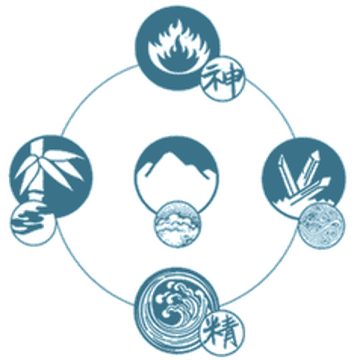Five Element postures from Earth and Nature
|
Taoist Immortals were called "xian" represented by a character showing a man next to a mountain. Living in the wild, untamed parts of the natural world, xian travelled alone or in very small groups. They attained strong vigor, healing powers and extended old age through Taoist practices such as SunDo. Primarily a breathing practice with postures, SunDo cultivates Qi in the tandien, an energy center located below the navel. |
Roaming in the mountains in divine alignment with the cycles of the natural world, these Taoists observed and used various elements of nature in SunDo practice. For them, nature was not a thing, but a dynamic process of which humans were an integral part. This relationship spurred the formation of postures sets that mimicked the way the five elements occur in the natural world.
|
The Cycles of Nature
Early Taoism flourished in remote mountainous regions with wandering sages or bands of hermits living apart from human-centered society. We can see this relationship reflected in the original sequencing of the five elements: the cosmological cycle. Before restructuring took place into the constructive and controlling cycles used for diagnosis in acupuncture, the cosmological cycle existed as a mandala representing wholeness with earth at the center. Not contrived for human purposes, the cosmological cycle of the five elements can be likened to a universal map of an organic and creative life force. It shows how the five elements symbolize the five movements in all living phenomena. |
Our Expansive Sense of Self
SunDo practice brings about a process of “self-realization” that expands the personal identity to include all life. The “self” does not stop at the skin, and not only with the private ego, but expands to include the entire cosmos. In SunDo, this process happens because of postures sequences that arose from shamanic practices and were based on the cosmological cycle of water, fire, wood, metal and earth.
SunDo practice brings about a process of “self-realization” that expands the personal identity to include all life. The “self” does not stop at the skin, and not only with the private ego, but expands to include the entire cosmos. In SunDo, this process happens because of postures sequences that arose from shamanic practices and were based on the cosmological cycle of water, fire, wood, metal and earth.
Following the patterns of nature, SunDo postures are sequenced to represent birth, growth, maturity, decay, and eventually death from which new life may arise. We can see this sequence in the five phases of growth in a tree:
|
1. A seed within the soil begins to grow. Roots travel downward into the earth.
2. Emerging from the ground, a seedling shoots upward toward sky. 3. Branches and leaves begin to grow outward in all directions. 4. Then, flowers and fruits form new seeds deep within. 5. Eventually, the fruits drop down to earth. Seeds scatter and grow again. |
Grounded and Centered in Earth
Of these five phases, all depend on earth to provide the stability of ground from which all things can grow and be nurtured. When we apply each phase to the five directions of movement, a pattern begins to take shape: Water represents downward movement. Fire represents upward movement. Wood represents expansive, outward movement in all directions. Metal represents contractive, inward movement toward the center. And Earth represents a stable center, or the ground from which all things arise.
|
SunDo postures are performed while simultaneously breathing into the lower dantien. This energy center then acts like a pump to infuse each posture with Qi through the meridian channels. Postures based on the cosmological cycles of the five elements awaken and activate these five energies. SunDo posture sets 1 and 2 balance the five elements within the physical, emotional and energetic systems within the body and mind. Once the five elements have become balanced, practitioners begin to work on uniting yin and yang energies in the third posture set. Stay tuned for more on posture set 3 in a future blog! |
|
SunDo Five Element Postures Slideshow
|



